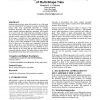Free Online Productivity Tools
i2Speak
i2Symbol
i2OCR
iTex2Img
iWeb2Print
iWeb2Shot
i2Type
iPdf2Split
iPdf2Merge
i2Bopomofo
i2Arabic
i2Style
i2Image
i2PDF
iLatex2Rtf
Sci2ools
101
Voted
GECCO
2007
Springer
2007
Springer
Activation energy-based simulation for self-assembly of multi-shape tiles
Building artificial systems using self-assembly is one of the main issues of artificial life [17]. Scientists are trying to understand this process either using experimental approaches or computer simulation approaches. This paper aims at supporting research using computer simulation approaches mimicking self-assembly as it occurs in the real world using basic principles in physics such as Brownian motion and basic concepts in Chemistry such as activation energy required to build molecules at molecular level. In this paper, a simulator has been implemented to mimic the process of self-assembly. In this simulator, objects are modeled by shapes such as cubes, tetrahedrons, wedges and pyramids with colors in their faces. The objects move randomly in Brownian motion, and the faces' colors determine how the objects interact with each other. Each object has its own probability to move which depends on the energy that the object gains through its interaction with other objects. The high...
| Added | 07 Jun 2010 |
| Updated | 07 Jun 2010 |
| Type | Conference |
| Year | 2007 |
| Where | GECCO |
| Authors | Mostafa Mostafa Hashim Ellabaan |
Comments (0)

